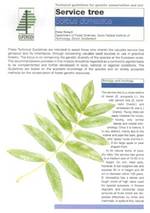Sorbus domestica - Technical guidelines for genetic conservation and use for service tree
This publication has been translated into the following languages:
Slovenian Italian
Conservation priorities and measures depend on the current population size, population structure and existing or potential threats. Thus, in situ conservation efforts must begin with inventories, assessing population size and structure, core populations, fragmentation, threats and threatening processes, as well as conservation needs and priorities.
No rule can be given regarding the minimum number and size of populations to be conserved since it depends on the specific situation of the species(demography, threat, habitat availability etc) and the available financial means. At the very least, the most viable core population should be designated as a conservation unit in which S. domestica is favoured above all other species in regeneration and tending operations. Focusing efforts on these core populations, which are the largest and most viable, should ensure maximum success with minimum costs. As a rule of thumb, at least 50 interbreeding individuals should be selected for such a conservation unit. Management should guarantee individual survival, favour vitality and fertility, and attempt to create a sustainable age structure for the future. All objectives and necessary measures need to be clearly defined, documented and integrated into local management plans.
Where additional measures are feasible, other core populations should be added to create a network of conservation units. If possible, core populations should be linked with neighbouring cores or should be enlarged in order to guarantee their long term survival. In addition, smaller demes and even single trees,which serve as stepping stones for gene exchange, should be integrated into the network. Until further information on gene flow is available, demes and individuals may be considered linked if they are closer than 3 km. In most cases, conservation and promotion of S. domestica requires plantations, since natural regeneration is sparse or inexistent. These should be restricted to favourable sites where the service tree is able to withstand natural competition with little intervention.
It is highly recommended that in situ conservation measures are accompanied by ex situ collections even if sufficiently large core populations still exist. Seed orchards can produce genetically diverse planting material which is difficult or impossible to collect from wild populations. In addition, ex situ collections may serve as genebanks or for breeding activities. High quality planting material is important since regeneration is usually achieved artificially.
Conservation efforts are most successful if they are integrated into common forestry practice. Information, training, and the perception of the species in the forest service are thus decisive for successful conservation and it is hoped that these guidelines serve as a starting point for this purpose.
Authors: Peter Rotach
Corporate Author: European Forest Genetic Resources Programme
Journal/Series: EUFORGEN Technical Guidelines for Genetic Conservation and Use
Publication Year: 2003
Publication Format: Folder; PDF
ISBN: 92-9043-573-9
ISBN 13: 978-92-9043-573-0
Language: EN
Pages: 6 p.

